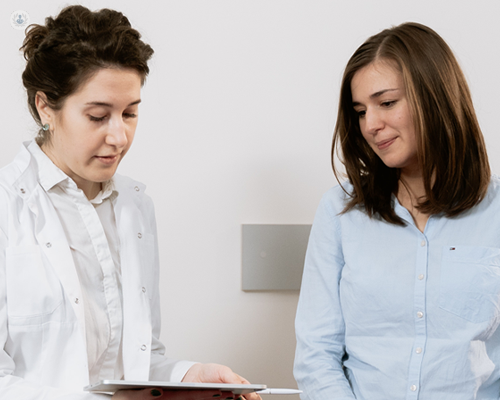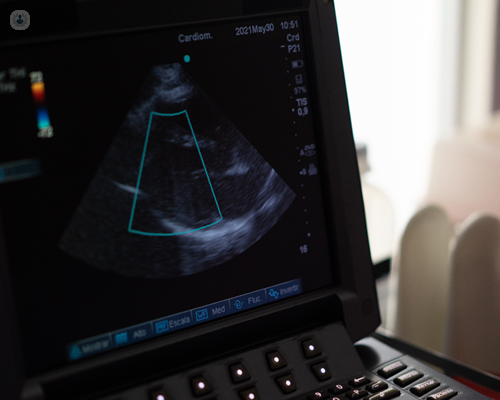Complex endometriosis
Mr Kirana Arambage - Obstetrics & gynaecology
Created on: 11-18-2024
Updated on: 12-12-2024
Edited by: Karolyn Judge
What is complex endometriosis?
Complex endometriosis is an advanced and severe form of endometriosis, a condition where tissue similar to the lining of the uterus (endometrium) grows outside the uterus. While typical endometriosis is often confined to the pelvic region, complex endometriosis extends deeper and may infiltrate nearby organs such as the bladder, bowel, ureters and, in rare cases, the diaphragm or lungs. This condition can cause severe pain, organ dysfunction and complications that significantly impact quality of life.

Complex endometriosis is classified based on the depth and location of the lesions. Deep infiltrating endometriosis (DIE) is a specific subtype that penetrates tissues more than five millimetres deep. It can form adhesions, which are bands of scar tissue that bind organs together, leading to additional discomfort and functional problems.
How serious is endometriosis that spreads to other organs?
When endometriosis spreads to other organs, it can become a serious medical condition requiring careful management. The involvement of organs such as the bladder or bowel can lead to symptoms like painful urination, blood in the urine, constipation, diarrhoea, or even bowel obstruction. In rare cases, endometriosis affecting the lungs or diaphragm may cause chest pain, breathing difficulties or coughing up blood during menstruation.
The severity of the condition depends on the organs involved and the extent of the disease. It can cause debilitating pain, infertility, and significant disruption to daily life. Delayed treatment may result in complications such as chronic pelvic pain, organ damage or the need for complex surgical interventions.

What are the treatment options for complex endometriosis?
Treating complex endometriosis typically involves a combination of medical and surgical approaches, tailored to the severity of the condition and the patient’s symptoms and goals. Non-surgical treatments aim to manage symptoms, while surgical options focus on removing or reducing endometriosis lesions.
Hormonal therapies are often used to suppress the growth of endometriosis tissue by reducing oestrogen levels. These may include contraceptive pills, progestin-based treatments or gonadotropin-releasing hormone (GnRH) agonists. Pain relief medications, such as non-steroidal anti-inflammatory drugs (NSAIDs), are also commonly prescribed to manage discomfort.
For patients with severe or complex disease, surgery is often recommended to remove endometriosis lesions, repair affected organs and restore normal function. This approach may be combined with medical therapy to prevent recurrence.

What's involved in surgery for complex endometriosis?
Surgery for complex endometriosis is a specialised procedure that aims to remove endometriosis lesions and adhesions while preserving as much healthy tissue and organ function as possible. It’s usually performed by a multidisciplinary team, including gynaecologists and surgeons with expertise in affected organs like the bowel or bladder.
Laparoscopic (keyhole) surgery is the most common technique used, offering a minimally invasive approach that results in shorter recovery times and less scarring. The procedure involves making small incisions in the abdomen through which a camera and surgical instruments are inserted. The surgeon identifies and removes or destroys endometriosis tissue using techniques such as excision or ablation.
In cases where endometriosis has caused significant organ damage, reconstructive surgery may also be required. For example, part of the bowel or bladder may need to be repaired or removed if deeply infiltrated by endometriosis.
Is surgery for complex endometriosis safe?
Surgery for complex endometriosis is generally considered safe when performed by experienced specialists. However, as with any surgical procedure, there are potential risks and complications. These may include infection, bleeding, injury to surrounding organs or the formation of new adhesions.
Because complex endometriosis often involves multiple organs, the surgery can be lengthy and technically challenging. Choosing a surgeon with expertise in managing complex cases is essential to minimise risks and ensure the best possible outcomes.

What's involved in recovery from complex endometriosis? How long does it take?
Recovery from surgery for complex endometriosis varies depending on the extent of the procedure and the individual’s overall health. For laparoscopic surgery, most patients can expect to return to light activities within one to two weeks and resume normal daily activities within four to six weeks. Open surgery, which is less commonly performed, may require a longer recovery period.
During recovery, patients may experience some pain, swelling and fatigue. Pain relief medication and post-operative care instructions are provided to aid recovery. Regular follow-up appointments are important to monitor healing and address any ongoing symptoms or concerns.
Lifestyle adjustments, such as maintaining a healthy diet and engaging in light physical activity, can support recovery. For some patients, additional treatments such as physiotherapy or counselling may be recommended to address chronic pain or emotional challenges related to endometriosis.
Is it possible to diagnose and treat endometriosis early to avoid it developing into complex endometriosis?
Early diagnosis and treatment of endometriosis are critical to preventing the progression to complex disease. Unfortunately, endometriosis is often diagnosed late due to its varied symptoms, which may be mistaken for other conditions such as irritable bowel syndrome or pelvic inflammatory disease.
If endometriosis is suspected, a thorough evaluation by a gynaecologist, including imaging tests such as ultrasound or MRI, can help confirm the diagnosis. In some cases, laparoscopy may be necessary to provide a definitive diagnosis.
Early intervention with medical treatments, such as hormonal therapies, can help slow the progression of endometriosis and reduce the risk of complications. Lifestyle measures, including managing stress and maintaining a healthy weight, may also play a role in reducing symptoms and preventing disease progression.

Which specialist treats complex endometriosis?
Complex endometriosis is managed by a multidisciplinary team of specialists, with a gynaecologist typically serving as the primary healthcare provider. Gynaecologists with expertise in endometriosis are trained to diagnose and treat the condition, including performing advanced surgical procedures when necessary.
For cases involving other organs, collaboration with specialists such as colorectal surgeons, urologists, and thoracic surgeons may be required. Pain management specialists, physiotherapists and mental health professionals may also be involved in providing comprehensive care for patients with complex endometriosis. Selecting a healthcare team experienced in managing complex cases ensures that patients receive tailored and effective treatment.
